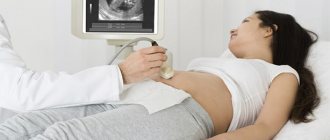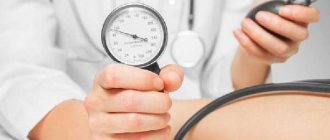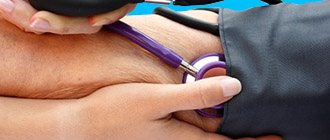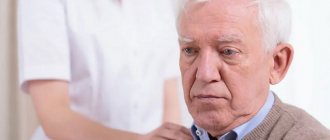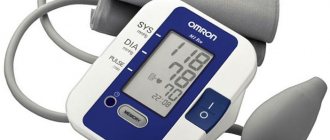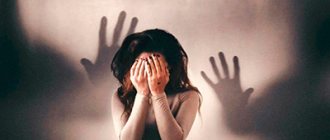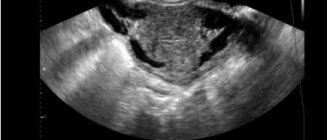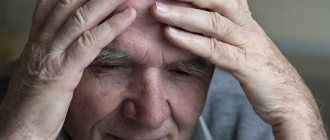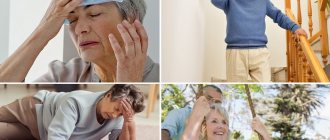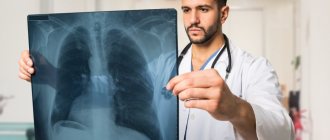From this article you will learn:
- What is considered normal blood pressure in older people?
- How to correctly measure blood pressure in an elderly person
- Is low blood pressure dangerous in older people?
- How to increase blood pressure at home for an elderly person
- What to do if an elderly person has high blood pressure
- What medications to take to normalize blood pressure
When a person is in a stable emotional and physical state, his blood pressure (BP) is normal. The reason for changes in indicators can be many factors. As for older people, their blood pressure, which can be high and low, can rise and fall several times a day. As soon as a deviation from the norm occurs, weakness, dizziness, loss of strength, poor health and apathy appear. It is impossible to remain inactive when the first signs appear, since blood pressure in older people can cause serious problems.
Blood pressure as a physiological process
Arteries are large vessels located in close proximity to the skin. This makes it quite simple to determine and raise blood pressure in an elderly person at home.
In addition, blood also moves through small capillaries and veins in the human body, which is why blood pressure is also called blood pressure. However, it can be quite difficult to measure it in such vessels without special instruments.
As you know, during work the heart contracts with a certain force and speed, releasing blood into the arterial system. For each person, this liquid may have different properties, just as the reaction of the walls of blood vessels to the release may differ. Blood pressure reacts especially acutely to this process in older people.
Recommended articles on this topic:
- Diseases of the elderly: diagnosis, prevention, treatment
- Diseases of the elderly: clinical features and treatment
- The main problems of older people and ways to solve them
Thus, blood pressure is the process of blood acting on the walls of blood vessels with a certain force.
Factors influencing this process:
- Loss of elasticity of the walls of blood vessels (atherosclerotic changes).
- The walls of blood vessels lose their elasticity and cannot withstand the load, which leads to hypertension and increased blood pressure in older people.
- Diseases of the endocrine glands.
- Sharp compression or stretching of blood vessels during strong emotions (fear, rage) or emotional stress. In addition, deformation also occurs during hormonal changes in the body.
- Each person’s heart works differently, contracts and distributes blood throughout the vessels.
- The rheological properties of blood when it becomes thicker and can clot. This leads to the fact that movement through the vessels becomes difficult, which can result in diabetes mellitus or a jump in blood pressure. In some cases, doctors recommend using hirudotherapy to thin the blood.
Origin of hypertension
There are essential and symptomatic forms of hypertension. Essential is the disease itself, and disturbances in the functioning of organs and systems are its consequence - the symptomatic form. The causes of high blood pressure in older people are quite difficult to detect, although there are risk factors that cause hypertension:
- Hereditary predisposition.
- Excess weight.
- Prolonged increased physical or emotional stress, which can lead to a stroke or heart attack.
- Production influences. The need to strain vision and perform mental functions. People's activities under increased noise or vibration levels, in a difficult emotional environment.
- Excessive consumption of coffee, salt.
- Alcohol, nicotine.
- Age-related changes in older people.
- Head injuries, kidney disease, high cholesterol, atherosclerotic changes.
There are three stages of hypertension:
- The first is an increase in pressure for a short period of time, then it normalizes when the cause that caused this phenomenon disappears.
- The second is an increase in blood pressure for a long time, which requires systematic medication.
- The third is high blood pressure for a long time, combined with dysfunction of blood vessels, heart, brain, and kidneys. If hypertension develops quickly, it is a malignant form; slowly, it is benign. In older people, the second option usually predominates.
Read material on the topic: Blood pressure in older people: subtleties and nuances
What is considered normal blood pressure in older people?
Normal blood pressure in older people has its own indicators, which are in a certain range of values. They may vary depending on age, nutrition, gender and climatic conditions. The norm for a healthy person is considered to be 120/80 mmHg. Art., however, it can be influenced by a number of factors.
In the table below you can see what pressure older people may have:
| Arterial pressure | Lower reading (mmHg) | Upper reading (mmHg) |
| Blood pressure (normal) | 110/70 | 130/85 |
| Low normal blood pressure | 100/60 | 110/70 |
| Hypotension, low blood pressure | less than 100/60 | |
| Increased normal pressure | 130/85 | 139/89 |
| Hypertension, high blood pressure | more than 140/90 |
In addition, blood pressure in older people has the following conditional norm for each age group:
| Age (years) | Lower reading (mmHg) | Upper reading (mmHg) |
| 16–20 | 100/70 | 120/80 |
| 20–40 | 120/70 | 130/80 |
| 40–60 | no more than 140/90 | |
| over 60 | no more than 150/90 |
Based on the tabular data, it can be seen that indicators begin to increase with age due to changes in heart rate, loss of vascular elasticity, etc. In addition, you have to deal with both high and low blood pressure.
As for what pressure older people should have, each person has their own norm, which can be determined by systematic measurements using a special device. Indicators must be recorded. If symptoms such as weakness, lethargy and headaches appear, you should measure your blood pressure at home for several days before going to the clinic or calling a doctor. When the norm is determined after regular measurements, it will be easy to understand whether in a particular case it is necessary to take medications or whether they are not necessary.
How to identify pathology?
A tonometer will help accurately diagnose changes. But they can also be identified by deterioration in well-being.
Blood pressure surges are accompanied by:
- Headache and dizziness;
- Alternating redness and paleness of the skin;
- Noise in the ears;
- The appearance of black dots before the eyes;
- Nausea and vomiting;
- Numbness of fingers;
- Cold extremities;
- Muscle tremors of the whole body;
- Tremor of the limbs;
- Slowing or increasing heart rate;
- Feeling of lack of air (shortness of breath);
- Aching or girdling pain in the chest area;
- Increased sweating;
- Severe weakness, fatigue and weakness (sometimes a person cannot even walk);
- Fainting and convulsions.
If such symptoms appear, it is necessary to measure blood pressure in both arms and monitor the readings for 2 hours, every 20-30 minutes.
How to correctly measure blood pressure in an elderly person
There are several ways to determine blood pressure in older people. Before prescribing medications to improve well-being, the doctor always focuses on the indicators of special devices. That is why measurements must be made according to instructions so that the diagnosis is correct and the treatment is appropriate.
To determine the pressure of people of any age, manual, automatic and electronic tonometers are used.
- The manual method involves the use of a cuff, which is placed on the arm in the area just above the elbow. The other holds a bulb, with the help of which air is pumped. At this time, the arrow on the device shows pressure. It is worth noting that this method requires certain skills, but it is accurate and reliable.
- The automatic method is not much different from the previous one, the only difference is the presence of an electronic display, which shows not only the pressure, but also the pulse.
- The electronic tonometer does everything itself; you just need to press a button on the display. It pumps air, after which you can see the necessary indicators on the screen.
The last two devices are the most convenient to use and accurate, however, in order to be confident in the readings, it is necessary to constantly monitor the battery and carry out preventative maintenance from time to time. This must be taken seriously, since the correctness of the diagnosis and the prescription of blood pressure medications for older people depends on these data.
Measurements must be taken in compliance with the following rules:
- 30 minutes before the start of measuring blood pressure, it is necessary to avoid physical activity and work, and also not to drink coffee, not to eat, to avoid smoking, and also try not to worry, that is, not to be exposed to emotional experiences.
- During the measurement, you need to be sitting in a relaxed state, and keep your legs uncrossed.
- For more accurate readings, you do not need to move or even talk at the time of measurement.
- The arm on which the cuff is attached should lie on a table or other surface at chest level, and your back should be straight.
- For greater accuracy, blood pressure in the elderly should be measured on both hands, but with a break of 5–10 minutes.
If after measurement there is a deviation of the indicators from the norms indicated in the table above, first of all you should check the device for damage. If everything is fine with him, then if you have high or low blood pressure in older people, especially those over 60 years of age, you should immediately consult your doctor.
Diagnosis of arterial hypertension
The first and key method for diagnosing hypertension is monitoring blood pressure. It is worth considering that for older people, blood pressure standards are higher than normal values.
Blood pressure should be measured at rest; after physical activity, you need to rest. The person should sit down, take a comfortable position, not cross their legs and not talk during the measurement. The cuff is placed on the shoulder at the level of the heart and 2 cm below the elbow. The pressure should be measured three times with an interval of 3-5 minutes, and the lowest value obtained should be taken as the result.
Why is low blood pressure dangerous in older people?
Why is low blood pressure dangerous in older people? If for a healthy middle-aged person such a phenomenon does not pose a particular threat, then for old people it can cause an ischemic stroke, which is already a proven fact.
An equally dangerous condition for an elderly person is a sharp decrease in pressure when standing up, that is, orthostatic hypotension. As a rule, it is accompanied by the following symptoms:
- darkening of the eyes;
- noise in the head;
- dizziness;
- deterioration of blood circulation in the brain.
In addition, the danger is that if you experience severe dizziness, you can faint and get injured. It is situations like these that make you think about how to quickly increase blood pressure in older people at home.
Quite often, in old people, one can observe a violation of the pulse difference or pressure, which is the difference between systolic and diastolic blood pressure. Normally it is 35–40 units. However, when an older person has a decrease in only one indicator, the difference can either decrease, for example, BP 90/80, or increase (120/55).
We recommend
“Why blood pressure drops in older people: causes and treatment” Read more
If there is a decrease in pulse pressure, this indicates that the heart is not coping with its functions, that is, it cannot fully pump blood, which means that in-depth diagnosis with subsequent treatment is necessary . The causes of low diastolic pressure in older people may also be hidden in diseases associated with the cardiovascular system, for example, poor valve tightness, which only a specialist can detect.
An elderly person should know how to quickly raise blood pressure at home and prevent attacks.
Preventive measures
To prevent blood pressure surges, you must:
- Regularly monitor blood pressure using a home blood pressure monitor;
- Avoid coffee and strong tea;
- Minimize fat and salt content in food;
- Eliminate smoked meats, sausages, and canned food from the diet;
- Increase consumption of sea fish, vegetables and fruits;
- Do not give up physical activity, but it should be moderate (exercise, walking) so as not to strain the body;
- Get enough sleep at night and rest during the day;
- Maintain body weight at the same level;
- Do not take medications that quickly lower blood pressure, which can cause collapse due to rapid drainage of blood from the brain and lead to death (this recommendation is especially relevant for people over 90 years of age).
How to increase low blood pressure in an elderly person
If hypotension has been observed for a long time or attacks associated with it periodically occur, then, regardless of why the pressure drops, older people should follow certain rules of behavior. This will help avoid fainting, ischemic stroke and other serious diseases.
You should not immediately move on to radical measures to increase blood pressure; you can use other methods to eliminate unpleasant symptoms. First of all, this concerns low blood pressure in older people, the cause of which is physiology.
- Every morning, without getting out of bed, take measurements on each hand. Do a similar procedure during the day and evening.
- You need to keep a notebook and write down readings in it, which will make the work of doctors easier if necessary.
- You can’t get out of bed abruptly; you must first sit down, sit, regain your breathing, and only then get up.
- The day of patients with chronic hypotension should begin with a hearty breakfast and a cup of coffee. During the day, be sure to eat healthy foods, well-salted, and drink more fluids.
- You should definitely go for a walk in the morning and evening, preferably walking or doing as much physical labor as possible.
- You should not stay in a stuffy room or in the heat for a long time, and you should also try to avoid physical and emotional stress.
If you follow all these rules, you can maintain normal blood pressure for a long time. However, what should you do if hypotension in an elderly person manifests itself with life-threatening symptoms?
We recommend
“Low blood pressure in older people: causes, symptoms and treatment” Read more
What if all of the above recommendations are followed, but the patient’s condition does not improve and the quality of life due to low blood pressure leaves much to be desired. In this case, the question of what to do when blood pressure drops in older people becomes very relevant.
What can you do if you have low blood pressure to feel better?
- Before taking anything, you should consult a specialist and discuss the problem with him.
- As a rule, doctors advise using alcohol tinctures with medicinal plants that have a mild hypertensive effect to increase blood pressure in older people rather than drugs.
How can an elderly person cope with low blood pressure at home?
- Purchase alcohol tinctures of Aralia Manchurian or Eleutherococcus at the pharmacy and take 30–40 drops diluted in 60 ml of water 2 times a day before meals.
- An alcoholic tincture of ginseng, which has a vasoconstrictor effect, is quite good. Dissolve 15–20 drops in a tablespoon of water and take after each meal.
- However, it is forbidden to take all these remedies without consulting a specialist, since they have serious contraindications.
A good psychostimulant is hawthorn infusion. To prepare it you need 1 tbsp. l. pour 200 ml of boiling water over the fruit, cover and leave warm for 2 hours. The finished strained solution should be taken before each meal, 1-2 tbsp. l.
However, it is worth noting that all of the listed remedies are not designed to quickly raise blood pressure in an elderly person; they are used for long-term treatment.
If the cause of hypotension is problems with the heart or endocrine system, then until the disease is cured, it is useless to look for ways to quickly increase blood pressure.
For primary, that is, essential hypotension, it is allowed to take drugs such as:
- "Pentalgin-N".
- "Citrapar".
- "Citramon".
- drugs containing caffeine, for example, "Acepar" (in case of urgent need to increase blood pressure).
To improve cerebral and general blood circulation, you can take Piracetam 1 tablet per day. The main thing to remember is that all medications can be taken only after consultation with a specialist.
Healthcare Institution "Myadel Central District Hospital"
Registration of the clinic - 8 017 97 24-3-89 Registration of the pediatric department of the clinic - 8 017 97 24-3-15 Reception of the chief physician (fax) - 8 017 97 24-3-80 Myadel emergency medical department of the Medical Institution "MotssMP" - 103 " _ _ _ _ hotline" - 8 017 97 22-3-21 Questions on the provision of medical care during the period of rising incidence of viral infections - 8 017 97 24-3-88 Tasks and functions: Public health is one of the main conditions for the successful implementation of the socio-economic development strategy The Republic of Belarus. The most important goal of the state in the field of health protection is to reduce the level of diseases, the spread of which poses a major threat to the health of citizens and national security. The main task of domestic healthcare is to preserve the principles of social equality in the provision of medical care. The Republic of Belarus has developed a legislative framework , which, among other things, establishes the equal right of citizens to affordable medical care. The fundamental documents are: - The Constitution of the Republic of Belarus (Article 45); — Law of the Republic of Belarus “On Health Care”; — Law of the Republic of Belarus “On State Minimum Social Standards”; The Constitution of the Republic of Belarus guarantees citizens of the country the right to health care, including free treatment in state health care institutions (Article 45). In accordance with the Law of the Republic of Belarus “On Health Care”, citizens of the Republic of Belarus have the right to affordable health care , which is ensured by: - the provision of free medical care in state health care institutions based on state minimum social standards in the field of health care; — provision of medical care in state health care organizations, non-state health care organizations and individual entrepreneurs at the expense of their own funds, funds of legal entities and other sources not prohibited by the legislation of the Republic of Belarus. The Law “On State Minimum Social Standards” establishes state minimum social standards in the field of healthcare (adopted by regional (Minsk City) Councils of Deputies for each region).
Tasks and functions of the Myadel Central District Hospital: - Implementation of a set of measures developed on the basis of the Law of the Republic of Belarus “On Health Care”, Decrees of the President of the Republic of Belarus, Decrees of the Government and the Ministry of Health of the Republic of Belarus, aimed at creating conditions for preserving and strengthening the health of the population of the region. — Ensuring accessibility of medical care for the population of the region, providing free medical care based on state minimum social standards in the field of healthcare. — Providing the population of the region with highly qualified inpatient and outpatient medical care. — Development and implementation of measures aimed at improving the quality of medical care for the population of the region, reducing morbidity, disability, hospital mortality, child and general mortality and improving the health of children, adolescents and women. — Timely and widespread introduction of modern methods and means of prevention, diagnosis, treatment and rehabilitation into the practice of all treatment and prevention organizations in the region. — Development, organization and implementation of measures for the deployment, rational use, professional development and education of medical personnel. — Operational, organizational and methodological management, as well as control over the work of all healthcare organizations in the district. — Priority development of primary health care. — Interaction and continuity with other healthcare institutions. — Implementation of government programs in the field of healthcare. — Carrying out work on hygienic education of the population and the formation of a healthy lifestyle. — Introduction of economic forms of management and increasing the efficiency of using allocated financial resources. — Improving and strengthening the material and technical base.
Objectives of the Myadel Central District Hospital: - Providing qualified, specialized medical care to the population of the entire region. — Implementation of operational, organizational and methodological management of rural treatment and preventive organizations. — Advisory assistance. — Planning and forecasting of health care in the region. — Monitoring the activities of health care organizations in the region. — Financing. Identification of economic priorities. — Supply of medical equipment and equipment. — Introduction of modern methods of prevention, diagnosis, treatment, rehabilitation and recovery. — Drawing up summary statistical reports. — Organization and implementation of preventive measures.
Tasks of a medical outpatient clinic: - Conducting appointments and providing care to patients at home. — Providing first aid for acute diseases and accidents (injuries, poisoning, etc.). — Ensuring the patient is referred to other medical facilities in accordance with medical indications. — Early detection of diseases, timely outpatient examination and treatment of patients. — Identification of patients in need of inpatient treatment and preparing them for hospitalization. — Ensuring continuity in examination and treatment with the hospital, emergency department of the Central District Hospital. — Work on the examination of temporary disability and issuance of certificates of incapacity for work. — Referral in the prescribed manner of persons with disabilities to VKK. — Conducting preventive medical examinations of persons subject to examination in the prescribed manner. — Clinical examination of the population: timely registration of persons subject to medical examination (patients and healthy people), ensuring dynamic monitoring of their health status, carrying out therapeutic and recreational activities. — Preferential provision of medical care to individual agricultural workers (machine operators, etc.). — Carrying out measures to provide medical care to agricultural workers during the period of mass field work. — Protecting the health of mothers and children. — Carrying out a set of sanitary and anti-epidemic measures (preventive vaccinations, etc.). — Notification of the district center of hygiene and epidemiology in the prescribed manner about infectious, parasitic and occupational diseases, poisoning of the population and identified violations of sanitary and hygienic requirements. — Carrying out sanitary education work. — Scheduled visits of doctors to assigned medical posts to monitor and provide practical assistance in their work.
Tasks of the FAP: - Reception of the population, provision of pre-medical care. — Identification of pregnant women and their patronage. — Observation of postpartum women at home. — Teaching pregnant women about pregnancy hygiene, hygienic child care, proper feeding, and protecting the child from infectious diseases. — Monitoring children under 1 year of age, patronage of children, carrying out measures to reduce infant and maternal mortality. — Medical services for kindergartens and schools. — Participation in medical examination, monitoring the health of machine operators, livestock breeders, etc. Timely identification of risk factors for non-communicable diseases, arterial hypertension. Conducting door-to-door visits for the purpose of early detection of cancer - Examination of the working conditions and living conditions of those undergoing medical examinations, monitoring the implementation of labor recommendations. — Prevention of agricultural and domestic injuries. — Sanitary and anti-epidemic work (door-to-door visits, work in the outbreak), current sanitary supervision, notification of the district center of hygiene, epidemiology and public health. — Organization of sanitary assets and their training. — Performing the function of a pharmacy. — Drawing up plans and reports.
Tasks of the local hospital: - Providing medical care to the population of the district in a hospital setting (outpatient). — Planning and implementation of measures for prevention and reduction of morbidity based on data on seeking medical care (primary, general, infectious morbidity, morbidity of the most important non-epidemic diseases, morbidity with temporary disability, hospitalized morbidity). — Carrying out measures to bring out-of-hospital care closer to agricultural workers during the period of mass field work. — Carrying out therapeutic and preventive measures to protect the health of mothers and children. — Introduction into practice of modern methods of prevention, diagnosis and treatment of patients, progressive forms and methods of work of medical organizations. — Organizational and methodological management and control over the activities of subordinate medical and obstetric centers. The local hospital (medical outpatient clinic) provides outpatient medical appointments in the main specialties (therapy, surgery, dentistry, etc.). In some cases (the absence of a doctor, his illness, vacation, a large number of calls), a paramedic is involved in outpatient appointments. Outpatient hours are set taking into account the seasonality of field work and the time of year for agricultural workers.
WE INVITE you to visit the clinic for examination as part of the DISPANSERIZATION!
Health care institution "Myadel Central District Hospital"
222397, Myadel city, Kommunisticheskaya street, 23, Myadel district, Minsk region, Republic of Belarus, phone: +375-17-97-24380 (reception), +375-17-97-24389 (reception).
Fax: +375-17-97-24380. E-mail: [email protected] , IT:
Look for us on social networks: VKontakte, Odnoklassniki, Facebook
Postal address of the main health department of the Minsk Regional Executive Committee:
220030, Minsk, Engelsa Street, 4, phone: +375-17-500-42-31 (reception of the head of the main health department).
Website: guzmo.gov.by Email
High blood pressure in older people
When an elderly person has an increase in blood pressure to 140/90 mm Hg. Art., he is diagnosed with hypertension. Today, this pathology is one of the most common among the elderly, and the number of sufferers is constantly growing.
Hypertension is a disease that is difficult to treat. As for the reasons for its appearance, there are many:
- overweight and obesity;
- bad habits (smoking and drinking alcohol);
- passive lifestyle;
- eating salt in large quantities;
- predisposition and diseases transmitted by inheritance;
- diseases associated with organs and endocrine glands;
- trauma, stress, emotional distress;
- additional factors.
In order to cope with high blood pressure in older people and keep the situation under control, it is necessary to determine what caused it. You must adhere to all the recommendations given by the doctor in order to eliminate the risk of complications in the future.
Most often, when high blood pressure accompanies an elderly person for a long time, symptoms such as dizziness, migraine, headache, shortness of breath and sleep disturbance may have been present before this.
We recommend
“High blood pressure in older people: treatment, prevention and folk methods of combating the disease” Read more
In some cases, people suffering from high blood pressure begin to experience changes in the retina of the eyeball, which often leads to blindness. Heart failure causes problems with the heart and blood vessels. In addition, due to poor blood supply to the brain, disorders and diseases associated with the membrane system are possible.
It is worth noting that persistently elevated blood pressure in older people can cause a hypertensive crisis (HC). This is a rather dangerous condition, since a sharp sudden increase in blood pressure affects the cerebral and renal circulation, which causes edema of the brain, lungs, myocardial infarction and stroke. In addition, each elderly person experiences this condition in their own way.
The difference in numbers can be quite large, while a person with a blood pressure of 200/150 can function quite normally, while someone with a blood pressure of 150/85 mm. rt. Art., feel very bad.
As a rule, HA occurs in elderly people with hypertension at a late stage of its development, but in some cases it can also be observed in a healthy person.
Some reasons for the development of hypertensive crisis:
- inappropriate physical activity;
- stress and overload of the body;
- sudden changes in weather and climate;
- eating salt in large quantities;
- taking inappropriate antihypertensive drugs;
- diseases of internal organs and endocrine system.
With GC, when blood pressure exceeds acceptable values, a person may experience severe headaches with nausea, vomiting and partial loss of vision, as well as panic attacks. With the development of HA, increased sweating appears, as a result of which a person loses a lot of moisture, hand tremors, chills or fever, and rapid pulse occur. In addition, loss of consciousness and sometimes even coma are often observed.
It is very important at such moments to provide first aid in a timely manner. This usually happens suddenly, so the first thing you should do is take an antihypertensive drug prescribed by your doctor, then call an ambulance. In such situations, very often a person is hospitalized.
If the patient has chills, then after wrapping him up, he should be placed on a flat surface with his head raised. The main thing is not to panic, an elderly person needs peace at this moment.
In addition, the list of necessary actions when providing first aid includes taking a drug that can quickly reduce blood pressure, so antihypertensive drugs that reduce the risk of the disease will be considered next.
Symptoms
Main symptoms of high blood pressure:
- Strong headache.
- Cardiopalmus.
- Decreased visual acuity.
- Sweating.
- Increased anxiety.
- Facial redness.
- Loss of coordination.
In some cases, high blood pressure may be accompanied by an increase in body temperature.
If such symptoms appear, you should immediately seek medical help. Only timely adoption of emergency measures can prevent the death of brain cells.
Features of the treatment of high blood pressure in the elderly
The reasons why blood pressure increases in older people vary, so treatment of hypertension should be carried out in such a way as to avoid possible complications. That is why the doctor must be able to react in time and, if necessary, change the method of administration of the drug.
If treatment is not organized correctly, the risk of vasoconstriction increases, resulting in a possible heart attack and stroke.
Attention also needs to be paid to the kidneys, since fluid from the body must leave the body in the required quantity, otherwise its accumulation can lead to increased pressure. Therefore, together with drugs aimed at lowering blood pressure, the doctor prescribes a diuretic. Although it is worth noting that modern medications for normalizing blood pressure levels already contain nephrological agents.
How to treat the disease?
If an elderly person’s blood pressure fluctuates, then first of all he needs to see a doctor. The specialist will conduct diagnostics to determine the cause of the pathology, individually select medications, adjust the dosage, and take into account the presence of chronic diseases and contraindications.
It is recommended to keep a diary to note after what actions the blood pressure decreased or increased, which will help the doctor prescribe the optimal treatment.
Self-medication is only possible as an emergency, after which you should call a doctor. Otherwise, it can lead to serious complications and death.
